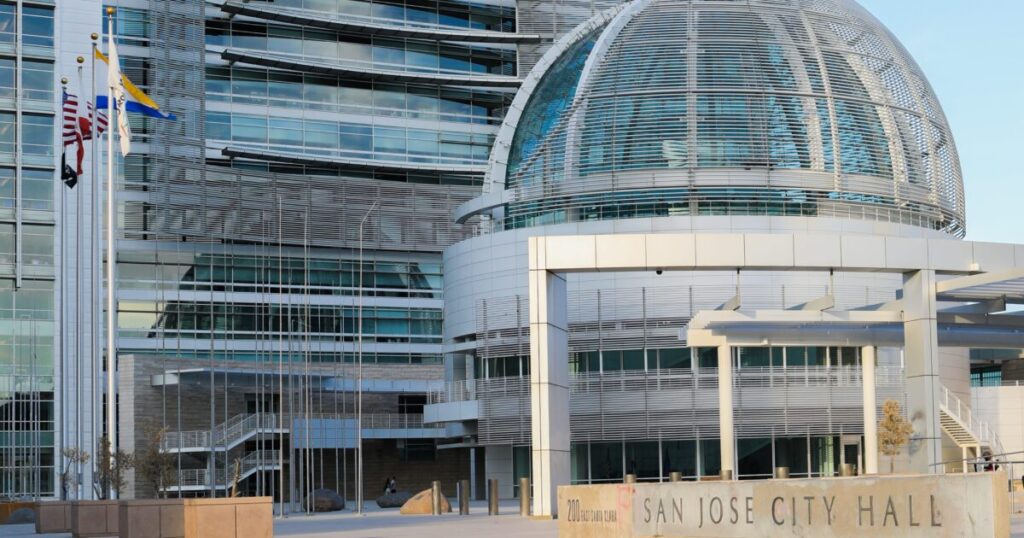San Jose’s projected budget deficit has been reduced by almost half since initial estimates from earlier this year, but the city still faces a growing housing crisis and major deficit next year.
The City Council previewed the proposed 2025-26 budget during a budget study session Wednesday, which drops the projected budget shortfall of $60 million to $35.6 million. The same can’t be said for the projected 2026-27 budget shortfall, which increased to $52.9 million. Measure E, a real estate property transfer tax approved by voters in 2020, was also a hot topic for discussion, as Mayor Matt Mahan doubled down on redirecting funds previously prioritized for affordable housing in order to get homeless residents off the street with temporary shelter.
City staffing has increased from 6,994 employees last year to 6,999 employees in the new proposed budget, though staffing is still down from the 2023-24 high of 7,040 employees. A hiring freeze remains in place for the rest of the fiscal year.
Jim Shannon, city budget director, said San Jose’s key strategy is to completely resolve the $35.6 million deficit and a portion of next year’s projected $52.9 million deficit.
“This budget would look very different if we didn’t have the direction to reallocate funding for Measure E to support homeless, sheltering and supportive services,” Shannon said at the meeting. “So that’s $39.2 million that shifted out of the general fund into the (Measure E) fund as part of the proposed budget.”
Funds originally prioritized for affordable housing development need to be used for San Jose’s growing temporary housing stock, Mahan said, because it will minimize the impact of the city’s budget shortfalls. He said councilmembers who want to propose alternatives would have to close or pause existing temporary housing sites.
“We committed to building out the interim housing that is already opening, has people in, is under construction and will open over the next few months,” Mahan said. “That’s not to say that a given council can’t change direction — but there’s also a cost to that.”
Budget officials estimate Measure E revenue to total $55 million this fiscal year and $60 million next year. About 85% of the funds will be used to build and run temporary housing sites.
Four temporary housing sites with a combined 524 beds or spaces have come online in the past eight months, including Pacific Motor Inn, the Branham Lane modular site, the Berryessa Safe Parking site and Via del Oro. More sites are scheduled to open, such as the safe sleeping site on Taylor Street in June, the Cherry Avenue tiny home site in September and five hotel conversions into shelters later this year.
Mahan in February called for shifting Measure E dollars to help fund operations at the city’s temporary housing sites. City elected officials then voted 7-4 to approve Mahan’s March budget message, with Councilmembers Pamela Campos, David Cohen, Peter Ortiz and Domingo Candelas dissenting.
Shannon said about $60 million in years of leftover housing allocation funds will go toward in limbo housing development projects from providers such as PATH, Habitat For Humanity, Abode Communities and more. San Jose is inviting housing providers to apply for this funding through March 3, 2026.
“We’re building out our portfolio of emergency interim housing without a dedicated revenue source to make sure that long term, we are planning fiscally responsibly to ensure we can do both,” Campos said Wednesday. “We can address our housing and homelessness crisis without affecting the ability for our city staff to provide the core services that our residents not just depend on, but deserve.” Mahan said Campos’ comment was a “fair call out,” but Measure E only ever mentioned affordable housing development as a strategy for addressing homelessness, not as a requirement.
Mahan said Campos’ comment was a “fair call out,” but Measure E only ever mentioned affordable housing development as a strategy for addressing homelessness, not as a requirement.
“What we’re doing today is not fast and cheap enough, not scalable enough, we may need to have a longer conversation about congregate, large, safe sleeping sites,” Mahan said. “(It’s) a whole ‘nother ball game here because we’re not even near meeting the need of the immense human suffering on our streets today.”
Budget discussions are expected to continue throughout the month until Mahan releases his final 2025-26 budget message June 2. Councilmembers will vote on the final budget June 10.
Contact Vicente Vera at [email protected] or follow @VicenteJVera on X.


